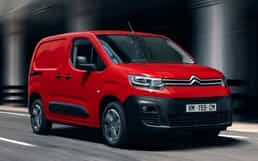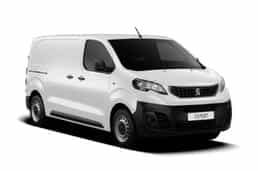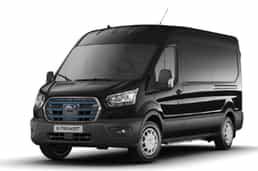Electric Vans / Electric Van Reviews / The Top 5 Electric Vans by Payload
There’s a perception that electric vans are heavy and that the payloads they can take are lower than their diesel equivalents. This is partially true, the battery pack is weighty and can restrict how much load can be carried. Things aren’t quite that straightforward though – our Van Expert Tim Cattlin takes a look at the top 5 electric vans by payload, and there’s a surprise or two in there…
As the smaller van is typically used in urban environments by small businesses, an electric version is probably going to appeal more than a zero-emission medium or large van. Why? Because the range between charges is less likely to be an issue, most vehicles returning to base at the end of the day with plenty of charge remaining and, with the advent of zero-emission zones, they will be able to enter inner city areas without paying a charge. On paper, the e-Partner ticks many boxes so it’s not surprising that, along with its platform sharing siblings from the Stellantis group it’s not only selling very well, it’s also won a number of industry awards.
Smaller vans are hit the hardest when it comes to the payload reduction you get in an electric version of an existing diesel van. Why? Because the battery pack is often of a similar size and weight as that in some of the larger vans so, with a much lower GVM than their larger siblings they are clearly going to take some pain. The Stellantis group has done a sterling job in retaining a decent payload in its award-winning small electric van. The Berlingo and its friends have always had a reputation for having class-leading carrying capabilities and this strength has been carried over to the electric derivatives.
The 803kgs is offered on the L1 van with its 3.3 cubic metres of loadspace, but if you need the 3.9cu/m volume provided by the L2, you’ll only drop down to 751kgs. In addition, with all these vans you’ll be able to tow a 750kg braked trailer and that’s not something possible on some other electric vehicles.
An excellent effort here from Maxus, achieving a very practical payload without using the government’s over 3500kg electric van dispensation, more on which later. The MH model isn’t short on loadspace either, the load length of 3019mm, width of 1800mm and height of 1792mm equates to a volume of 9.7 cubic metres. If that’s not enough, the LH with 3419mm load length and 11cu/m volume still manages a payload just 40kg less than its shorter sibling. Is there a catch? Well, yes, you’ll need to specify the smaller battery pack to get these payload numbers although the official range of 112 miles whilst nowhere near class-leading could be enough for many operating in our towns and cities.
All these vans share the same bodyshell and running gear as they’re all manufactured by the Stellantis group, even the Toyota which is built by the Italian company thanks to a commercial agreement. I’ve taken the figure for the Vauxhall, although there are some minor variations across the different badges. To get this payload, you’ll need to specify the Vivaro with the smaller of the two available battery packs and take the Prime trim level. What’s impressive though is that all models of Vivaro Electric including the longer and heavier L2s have a payload of at least 1000kgs, a figure that traditionally would have been considered acceptable for a diesel-engined medium panel van.
OK – so you might wonder how Ford (watch our video review) manages to achieve such a high payload, one which the diesel version cannot compete with. It’s easy to explain. In an (almost) genius move, the government recognised that van operators might find the reduced payload on an electric van enough to put them off from making the transition. So, a derogation, or dispensation has been provided which allows a driver with a licence that normally restricts them to a van with a GVM (Gross Vehicle Mass) of 3500kgs to get behind the wheel of an electric van with a GVM of up to 4250kgs. Ford, despite being late to the party with an electric van, was one of the first manufacturers to take advantage of the concession, allowing operators to carry substantial payloads in a zero-emission vehicle.
There are one or two caveats to the scheme relating to vehicle testing, tachographs being required under certain circumstances etc, but there are signs that some of these restrictions are currently under review.
Trouncing the opposition is the Ducato Electric with an astounding payload of over 1900kgs. Here’s another van taking advantage of the 4250kg GVM derogation which allows for this impressive figure providing you specify the medium wheelbase version with the lowest roof height available, and the lighter, 3-module battery pack. This still has a load length of 3120mm which provides a loadspace volume of 10cu/m. There is a price to be paid however, the official WLTP Combined test cycle result is a range of just 99 miles, and if you’re using all that payload capacity in the real world you’ll get nowhere near that distance before needing a top-up.
You might wonder why this isn’t a joint award with the other Stellantis large vans such as the electric versions of the Vauxhall Movano, the Citroen Relay and the Peugeot Boxer. That’s because, in the large van, Fiat uses its own, in house built electric drivetrain, whilst its siblings are converted by an external provider using different technology.
Don’t be put off by looks that some might consider dated – I’ve driven the Ducato, it’s got a great cab, lots of advanced safety tech, a practical load area and it has deservedly won some major industry awards.
One thing is for sure, this article will soon become out of date as manufacturers compete amongst themselves, indeed soon to go on sale are revised vans from Stellantis which may well affect their ranking in our top 5. Watch this space…
 Ask for AvailabilityCitroen Berlingoe-BERLINGO Van 800 M 50kWh Enterprise Pro
Ask for AvailabilityCitroen Berlingoe-BERLINGO Van 800 M 50kWh Enterprise Pro
Go to deal
 Ask for AvailabilityPeugeot ExpertExpert Van Electric 75kWh Pr/Pm
Ask for AvailabilityPeugeot ExpertExpert Van Electric 75kWh Pr/Pm
Go to deal
 Ask for AvailabilityFord TransitE-Transit 350 L2H2 68kWh 184ps Trend
Ask for AvailabilityFord TransitE-Transit 350 L2H2 68kWh 184ps Trend
Go to deal